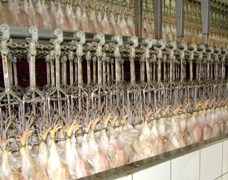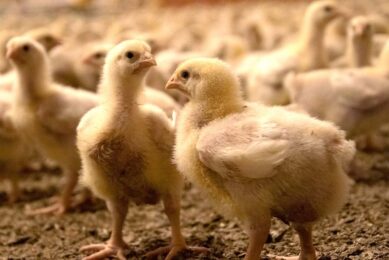Optimal feed withdrawal minimises losses at processing

Feed withdrawal in broiler flocks that are about to be taken to slaughter, greatly influences processing and carcase quality. It does not only affect carcass yield, but also increases the operating expenses if this is not done properly. Managing this process well in advance at the farm, may help reduce unwanted consequences later on in the processing plant.
By Eduardo Cervantes Lopez, International Processing Consultant, Barranquilla, Colombia
Feed withdrawal is the first stage in the process once the chickens have reached the required live weight for sending to the processing plant. This operation seeks to ensure that the chickens arrive at the plant with their digestive system as clean as possible, so that the process can develop normally.
It is recommended that eight to twelve hours should span between the moment it is decided to send a chicken to the slaughter plant and the actual slaughter. Under normal circumstances, the transit of food through the digestive system takes about eight hours.An adequate feed withdrawal ensures that between 80% and 85% of the intestinal contents have been evacuated during the first six hours prior to processing.
Measures in advance
In addition to lifting the feeders in the chicken houses, the following activities must be performed in a disciplined way, in order to guarantee the cleanliness of the intestinal tract.
In addition to lifting the feeders in the chicken houses, the following activities must be performed in a disciplined way, in order to guarantee the cleanliness of the intestinal tract.
• All drinkers must have enough water and be located at the proper height (according to the size of the chickens) for the animals to have easy access to it. If chickens do not find water in the drinker, they lie down. This delays the movement of food through the digestive tract.
• The lights in the chicken house must be on.
• Flock keepers should keep birds in motion. They should walk regularly and slowly among the birds or around them, while making noises to ensure that chickens are kept walking and standing most of the time.
• The chickens should be kept relaxed even if they are active.
Catching should start at least five hours after lifting the feeders. This is a very traumatic experience for birds because it slows the normal movement of food along the digestive system
Environmental conditions also affect the quality of the feed withdrawal. Just to mention a few: Walk around the stacked crates and watch the faeces on the floor: you will note that they contain small orange particles. These particles are small fragments of the intestinal mucosa, which have been evacuated due to the dehydration process experienced by birds. This is a way to confirm the existence of over-fasting before slaughter.
Special situations
In hot weather, chickens start the natural defence mechanisms: they lie down, lower their activity and increase water consumption. This last element affects the consistency of the faeces inside the intestines, rendering it watery. As the temperature approaches 32ºC or above, food is retained for longer in the crop, gizzard and small intestine.
In hot weather, chickens start the natural defence mechanisms: they lie down, lower their activity and increase water consumption. This last element affects the consistency of the faeces inside the intestines, rendering it watery. As the temperature approaches 32ºC or above, food is retained for longer in the crop, gizzard and small intestine.
Similarly in the late afternoon and into the night, as the temperature decreases the chickens gorge themselves. If feed withdrawal starts later, then fasting must be extended by at least 2 or 3 hours, so that the evacuation process of digestion residue takes place normally.
In cold weather, when the ambient temperature is low (-15°C), the chickens use again their natural defence mechanisms: they lie on the bed of the chicken house and remain in that position. In this new position, the transit of food is slowed because the crop, proventriculus and gizzard are affected by the pressure against the bed.
Yield, quality and safety
It has been established that, in normal feed withdrawal (8-12 hours), the weight losses range between 1.5% and 2.0%. In the case of long feed withdrawal, weight loss gradually increases and goes from 0.25% to 0.5% per hour.
During a normal feed withdrawal, the amount of faecal material in the chickens’ intestinal tract is minimal. Therefore, the amount of bacteria in the legs and feathers (which is a result of defecation during transport and storage on the ground) is significantly reduced.
Similarly, the bacterial count in the scalder water is minimal. The amount of faeces excreted during the hanging, stunning, slaughter and bleeding is greatly reduced.
If the digestive tract is relatively empty, the risk of faecal contamination is minimal. The evisceration process develops normally: consequently, water consumption is reduced by not reprocessing carcasses. In addition, the E.Coli count is also low.
Short feed withdrawal
When the digestive tract is full of food, once chickens are processed, serious problems of inaccuracy in the weight of the covers appear: the undigested food must be removed and sent to waste water. This represents actual losses.
When the digestive tract is full of food, once chickens are processed, serious problems of inaccuracy in the weight of the covers appear: the undigested food must be removed and sent to waste water. This represents actual losses.
As noted earlier, the evisceration process becomes very risky in terms of faecal contamination, given the amount of food and faecal material contained in the various organs of the digestive system. Water consumption increases due to the larger number of re-processed carcasses. This has a direct impact on the normal development of this process phase.
Long feed withdrawal
During evisceration, all consequences of inadequate feed withdrawal, which affect the quality and yield of the processed carcasses, are observed. When the intestines become fragile, due to the evacuation of much of the inner layers mucosa and submucosa, ruptures increase despite careful handling to remove the intestinal package. Accordingly, the content spills internally and/or externally. The abdominal cavity and the carcass are contaminated.
During evisceration, all consequences of inadequate feed withdrawal, which affect the quality and yield of the processed carcasses, are observed. When the intestines become fragile, due to the evacuation of much of the inner layers mucosa and submucosa, ruptures increase despite careful handling to remove the intestinal package. Accordingly, the content spills internally and/or externally. The abdominal cavity and the carcass are contaminated.
This critical situation will require the removal of the carcasses for reprocessing, increasing water consumption and extending the processing time. This task must be done carefully in order to eliminate the risk of E. coli and salmonella.Like the intestines, the tissues of the gallbladder become brittle; since this organ gradually increases in size until its bile storage capacity is maxed. When manipulating the gallbladder, in order to separate it from the liver, it might easily break, staining the carcass. If the carcass is not washed within 15 seconds, the stain will become permanent and the carcass will be classified as lower grade B or C.
Economic impact
When the gizzard shrinks, it also increases the adherence of the cutica gastrica. Therefore, in order to extract it, a greater pressure against the strip rollers is required. This removes an excess of flesh that ranges between 20% and 80%.
When the gizzard shrinks, it also increases the adherence of the cutica gastrica. Therefore, in order to extract it, a greater pressure against the strip rollers is required. This removes an excess of flesh that ranges between 20% and 80%.
To further illustrate the economic impact of a long feed withdrawal on the gizzard, let’s assume that a plant processes 100,000 chickens daily. Let’s also assume that 20,000 gizzards have this problem. A processed gizzard, without the proventriculus and fat, has an average weight of 22 grams. Calculating a minimum loss of meat of 20%, this means 4.4 grams totalling 88 kilos per day or 26 400 kilos per year.
This is a fortune for a product that has a high demand. It also increases water consumption and adds extra processing time. The greater adherence to the abdominal cavity, which characterises the crop, makes it more difficult to remove either manually or automatically. Therefore, this task will take longer, creating bottlenecks and sometimes requiring overtime. In addition, it runs the risk of leaving crop residue in the neck.
MORE INFORMATION
Join 31,000+ subscribers
Subscribe to our newsletter to stay updated about all the need-to-know content in the poultry sector, three times a week. Beheer
Beheer








 WP Admin
WP Admin  Bewerk bericht
Bewerk bericht